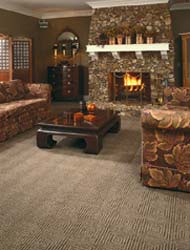Questions? Call Us:
Selecting Residential Carpet
Carpet - nothing looks like it, feels like it or performs like it. It enhances the peace and quiet of your home by absorbing sound. It insulates against the cold, cushions your feet with comfort, and adds safety—helping to prevent slips and falls and protecting dropped objects from being damaged. And because carpet is a key decorative element in the home and a major purchase, you must keep several factors in mind during your selection process. Perhaps the most important things to consider are these: Does it fit your taste, and does it match your lifestyle? This informative section was created to help you make a selection that best suits your home and your budget. quiet of your home by absorbing sound. It insulates against the cold, cushions your feet with comfort, and adds safety—helping to prevent slips and falls and protecting dropped objects from being damaged. And because carpet is a key decorative element in the home and a major purchase, you must keep several factors in mind during your selection process. Perhaps the most important things to consider are these: Does it fit your taste, and does it match your lifestyle? This informative section was created to help you make a selection that best suits your home and your budget.Location/Use Before purchasing carpet, you need to answer the following questions: How is the room going to be used? Will it have heavy or light traffic? Will the room be the center of activity for family and entertaining? Is there direct access from outside, or will the carpet be away from entrances? Will the carpet receive direct sunlight? Where there is to be heavy traffic (usually the family room, hallways and stairways), choose the best carpet you can afford. When shopping for carpet, look for performance rating guidelines with various brands of carpet. This rating system offers guidance on choosing the carpet that will perform best for various traffic needs. Most guidelines will be based on a 5-point scale, with the number 4 or 5 rating being best for the highest traffic areas. A 2 to 3 rating is good for areas with less traffic. Color Because it covers so much living space, carpet is the foundation of your room’s décor. It can be a neutral color, blending in with fabrics and other surfaces; or it can be a vibrant focal point of the room, making a statement that reflects your style. The selection of carpet color is a very personal choice. Carpet comes in almost every color, pattern, and texture you can imagine. You will want to select a color that unites your decorative elements and creates the atmosphere you desire. Ever-popular beige carpet can make a room look spacious; but for a bolder statement, look for a common color in your furniture and draperies. Choose a carpet with a similar hue. Environmental colors, like blues, deep greens, rosy quartz, and stony neutrals are becoming increasingly popular. Warm colors can turn up the heat in a room that lacks light, while cool greens and blues have a calming effect. Lighter colors make the room seem larger; darker colors provide coziness. There are also practical considerations in color selection. New stain and soil resistant technology makes today's lighter color carpet much easier to clean, allowing more decorating options. Medium and darker colors, tweeds, and textures will help disguise common soil in your home's high traffic areas. Cost Your budget and your needs are two key elements in selecting carpet and rugs. There are a wide range of choices and costs from which to make your selection. Ask yourself how long you expect to keep your carpet before replacing it. A better grade of carpet will give you a greater length of service than one of lesser quality. Buy the best carpet you can afford for the heavy traffic areas of your home—halls, stairs, and family rooms. A medium grade will provide good service in rooms with less traffic—bedrooms and guest rooms. The cost of carpet is based on many factors, including fiber, construction, quality, and design. Construction: Textures and Patterns Today’s carpet offers much more than a conventional loop pile. To add to a room’s sophistication and interest, consider choosing a textured pattern. New technology can produce multilevel loop and cut/loop patterns. Choose diamonds, bows, pin dots, or fleurs-de-lis designs that "pop out" in sculptured effects. The texture, colors, and pattern of the carpet can be made to complement or contrast with patterns of your furniture and window treatments. Using a solid color, textured carpet is a great way to provide interest and pizzazz, without going to a multicolor, overall pattern. Textured styles also fit well with today’s active and casual lifestyles. Textured carpet can be created through the use of several construction techniques. Many of these styles are known for their soil-hiding ability. Cut pile: Loops are cut, leaving individual yarn tufts. Still one of today's most popular constructions, its durability is achieved with factors including the type of fiber, density of tufts, and the amount of twist in the yarn. Plush / Velvet -- Smooth, level surfaces; formal atmosphere, "velvet." Saxony -- Smooth, level finish, but pile yarns have more twist so that the yarn ends are visible and create a less formal look. Minimizes foot prints. Friezé -- In this cut pile, the yarns are extremely twisted, forming a "curly" textured surface. This informal look also minimizes foot prints and vacuum marks. Level loop pile: Loops are the same height, creating an informal look. It generally lasts a long time in high-traffic areas. Many of today’s popular Berber styles are level loop styles with flecks of a darker color on a lighter background. "Multi-level loop pile: Usually has two to three different loop heights to create pattern effects, providing good durability and a more casual look. Cut and loop pile: Combination of cut and looped yarns. Provides variety of surface textures, including sculptured effects of squares, chevrons, swirls, etc. Really Express Yourself! Perhaps you are ready to boldly express yourself with a floral, fleur-de-lis, or multicolored carpet that will enhance plaids, stripes, or solids furnishings. European, English, French Country, and Colonial are some of the descriptive words used for the beautiful combinations of patterned carpet used with patterned furnishings. Fibers Fiber is carpet’s basic ingredient. The type of fiber used and the way the carpet is constructed determine how well the carpet will stand up to spills, pets, and daily traffic. Approximately 97 percent of all carpet is produced using synthetic fibers that are designed to feature style, easy maintenance, and outstanding value. There are five basic types of carpet pile fibers. Nylon: It is the most popular and represents two-thirds of the pile fibers used in the United States. Wear-resistant, resilient, withstands the weight and movement of furniture, and provides brilliant color. Ability to conceal and resist soils and stains. Generally good for all traffic areas. Solution-dyed nylon is colorfast because color is added in the fiber production. Olefin (polypropylene): Strong, resists wear and permanent stains, and is easily cleaned. Notably colorfast because color is added during fiber production. Resists static electricity and is often used in both indoor and outdoor installations because of its resistance to moisture and mildew. Used in synthetic turf for sports surfaces, and in the home for patios and game rooms. Many Berbers are made of olefin. Polyester: Noted for luxurious, soft "hand" when used in thick, cut-pile textures. Has excellent color clarity and retention. Easily cleaned, and resistant to water-soluble stains. Acrylic: Offers the appearance and feel of wool without the cost. Has low static level and is moisture and mildew-resistant. Commonly used in velvet and level-loop constructions, and often in bath and scatter rugs. Wool: Noted for its luxury and performance, wool is soft, has high bulk, and is available in many colors. Generally, wool is somewhat more expensive than synthetic fibers. Blends: A wool/nylon blend combines the superior look and comfort of wool with the durability of nylon. Acrylic/olefin and nylon/olefin are other popular blends, offering good characteristics of each fiber. Measurement: square yard/ square foot comparison To determine the approximate quantity of carpet you will need, multiply the length (feet) of the room by its width (feet) for the square footage. To obtain the square yardage, divide that figure by 9. Your retailer may figure the amount in square feet or square yards. Add 10 percent to account for room irregularities and pattern match. It is best to have your installer make final measurements to ensure that you purchase the correct amount. As professionals, they know how to include hallways and closets, match patterns, plan seam placement, work with room irregularities, and account for rooms with widths greater than 12 feet. (Most carpet is produced in 12- and 15-foot widths.) Dealers may sell by the square foot or the square yard. Quality Factors The type of fiber used and the way the carpet is constructed determines the basic performance of the carpet. Quality can be enhanced by the way the fibers, or yarns, are twisted and heat set, and by the density of the tufts. Deep pile height that’s densely tufted, has a luxurious feel; however, pile height is really a matter of personal choice and does not, in itself, denote durability. Performance Glossary Density – refers to the amount of pile yarn in the carpet and the closeness of the tufts. The denser, the better. Twist – the winding of the yarn around itself. A tighter twist provides enhanced durability. Heat-setting – the process that sets the twist by heat or steam, enabling yarns to hold their twist over time. Important in cut pile carpet. Most nylon, olefin and polyester cut pile carpets are heat-set. Performance – Some manufacturers have a rating scale for choosing carpet for various traffic areas – high, moderate or low. BCF OR STAPLE? When it comes to durability, there is little difference between bulked continuous filament (BCF) or staple (spun) fibers. The difference lies in the length of the fibers in the yarn, with staple having shorter lengths, giving the yarn more bulk (sometimes described as being more like wool). When carpet is manufactured with staple fiber, there will be initial shedding of shorter fibers. It will soon stop, depending on the amount of foot traffic and frequency of vacuuming. Wool is a naturally staple fiber; nylon and polyester can be staple or continuous filament; and olefin (polypropylene) is usually BCF. Article Source: The Carpet and Rug Institute |



